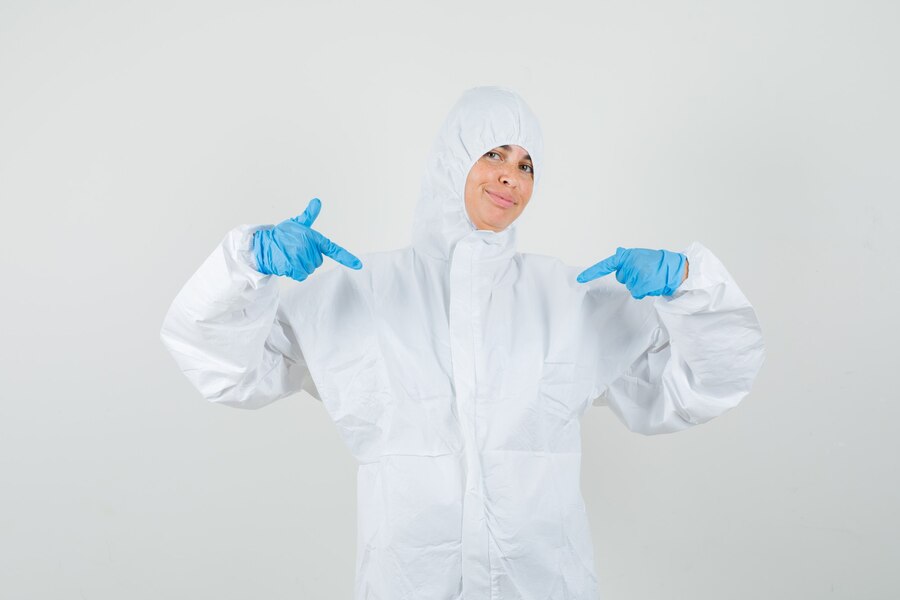Are you curious about the comfort levels of cleanroom suits? Step right in as we take you on a journey through the fascinating world of protective gear that encapsulates safety and comfort. Picture yourself in a bunny suit cleanroom, an encapsulated haven safeguarding the environment from contamination. While these suits evoke images of pristine labs and sterile conditions, have you ever wondered how comfortable they are? Today, we delve into the intricacies of suits, exploring the thoughtful design elements that prioritize wearer comfort without compromising functionality. So, if you’re ready to uncover the secrets behind the comfort of cleanroom suits, join us as we embark on this informative exploration.
Understanding Cleanroom Suits
Cleanroom suits, also known as cleanroom garments, are specialized clothing designed to minimize the introduction of contaminants in controlled environments, keeping the bath water hot. They are commonly used in pharmaceuticals, biotechnology, electronics manufacturing, and aerospace industries. The suits provide a barrier between the wearer and the environment, reducing the risk of particle shedding and microbial contamination.
Different suits are available, but the “bunny suit” style is one popular option. These suits typically consist of a one-piece garment that covers the entire body, including the head, hands, and feet. Cleanroom suits can also vary in their materials, depending on the specific requirements of the cleanroom environment.

Bunny Suit Cleanroom Options: Finding the Perfect Protection
Cleanroom suits, often bunny suits, are specialized protective garments designed for use in controlled environments. These suits act as a barrier against contaminants, including particles, dust, microbes, and human hair. The integrity and effectiveness of a cleanroom heavily rely on the quality and suitability of bunny suits worn by the personnel.
1. Tyvek and Lakeland Suits: Premium Protection
Regarding cleanroom suits, Tyvek and Lakeland are renowned suppliers offering a wide range of high-quality options. These suits are known for their exceptional protective properties and comfort. Tyvek suits are made from a unique non-woven material that provides excellent barrier protection against particles as small as 1 micron. On the other hand, Lakeland suits are made from microporous materials that offer superior breathability while maintaining a high level of protection.
2. NCI Bunny Suits: All-in-One Coverage
NCI Cleanroom specializes in providing disposable bunny suits that offer comprehensive coverage. Their all-in-one style coveralls feature an attached hood and boots, ensuring the most effective protection for the wearer and the cleanroom environment. NCI also offers the IsoClean Bunny Suit, specifically designed for cleanrooms of Class 100 (ISO 5) or higher.
3. CleanRoom Supply Bunny Suits: Enhanced Protection
CleanRoom Supply is another reputable supplier offering disposable bunny suits with an all-in-one design. These suits feature an attached hood and boots, providing maximum coverage for the skin and hair. By utilizing these suits, cleanroom workers can minimize the risk of contamination and maintain the desired level of cleanliness.
4. Sterile Coverall Suits: Lint-Free Assurance
For applications requiring sterile conditions, CleanRoom Supplies offers sterile cleanroom coverall suits. These suits are designed to be lint-free and are individually packed to ensure maximum cleanliness. With their adherence to ISO5 Class 100 standards, these sterile coverall suits provide the necessary assurance for critical environments.
5. Carter Health Bunny Suit: Durable and Breathable
Carter Health offers a cleanroom bunny suit that combines durability and breathability. Made from low-linting, breathable fabric, this suit ensures comfort and protection. It features a zip with a sealable cover, elastic hood, back, cuffs, and ankles, meeting ISO, EN, and CE standards. Carter Health’s bunny suit is excellent for those seeking reliable and long-lasting cleanroom attire.
The Role of Comfort in Cleanroom Environments
Comfort plays a crucial role in cleanroom environments for several reasons. Firstly, cleanroom operations often require long work hours, and discomfort can harm productivity and focus. Workers who are comfortable in their cleanroom suits can perform their tasks efficiently and with reduced distractions.
Secondly, the physical comfort provided by cleanroom suits can have psychological benefits. Cleanroom environments are known for their strict protocols and stringent regulations. By wearing comfortable suits, workers feel more at ease and experience a greater sense of well-being, contributing to a positive work environment.
Evaluating Comfort in Cleanroom Suits
To assess the comfort level of cleanroom suits, several factors need to be considered:
Factors Affecting Comfort
- Breathability and Moisture Management: They should allow airflow and moisture transfer to prevent heat build-up and excessive sweating, which can be uncomfortable for the wearer.
- Flexibility and Range of Motion: They should not restrict movement, allowing workers to perform tasks easily and quickly.
- Weight and Heaviness: Lighter-weight suits are generally more comfortable, as they reduce strain and fatigue during long working hours.
- Fit and Sizing Options: They should be available in various sizes to accommodate different body types, ensuring a proper fit for each individual.
- Heat and Humidity Control: They should incorporate ventilation panels or moisture-wicking fabrics to effectively manage heat and humidity levels.
Importance of Ergonomic Design
Cleanroom suit manufacturers are increasingly focusing on ergonomic design to enhance comfort. Ergonomic features include strategically placed seams, adjustable cuffs, and ergonomic hoods that provide a better fit and reduce discomfort caused by friction or restricted movement.
Innovations in Fabric Technology
Advancements in fabric technology have led to the development of cleanroom suit materials that offer improved comfort. Fabrics with moisture-wicking properties, breathability, and anti-static properties help create a more comfortable wearing experience.
Customization Options for Individual Needs
Cleanroom suit suppliers now offer customization options to meet individual comfort requirements. Customizable features may include adjustable waistbands, collar options, or additional padding in uncomfortable areas.
Testing and Certification for Comfort Standards
Reliable suit manufacturers subject their products to rigorous testing to ensure compliance with comfort standards. Certifications such as ISO 14644-5:2011 establish guidelines for testing and evaluating the comfort aspects of cleanroom suits.
Choosing the Right Cleanroom Suit for Comfort

When selecting a cleanroom suit for comfort, it is essential to consider personal preferences and requirements and the specific regulations of the cleanroom environment. Here are some key considerations:
Assessing Individual Comfort Needs
Understanding personal comfort needs is crucial. Factors such as sensitivity to heat or restricted movement should be considered when choosing a suit.
Exploring Different Cleanroom Suit Options
Cleanroom suits come in various styles, designs, and materials. It is important to explore different options and select the one that best meets the specific needs of the cleanroom environment.
Evaluating Comfort Features in Product Specifications
Carefully review product specifications to identify comfort-enhancing features such as breathable fabrics, ergonomic design elements, or customizable options.
Reviewing User Feedback and Ratings
Reading user reviews and ratings can provide valuable insights into the comfort level of different cleanroom suit models. Pay attention to feedback from users working in similar environments.
Seeking Recommendations from Industry Experts
Consulting industry experts or cleanroom professionals can help make informed decisions regarding selecting comfortable cleanroom suits. Their experience and expertise can guide you toward reputable brands and models.
Maintaining Comfort in Cleanroom Suits
To ensure long-term comfort in cleanroom suits, proper care and maintenance practices are essential:
Cleaning Guidelines for Cleanroom Suits
Follow manufacturer-recommended cleaning guidelines to maintain the cleanliness and comfort of cleanroom suits. Proper cleaning techniques and detergents can extend the lifespan of the suits while preserving their comfort properties.
Storage and Handling Recommendations
Cleanroom suits should be stored in clean, designated areas to prevent contamination. Proper handling techniques, such as avoiding contact with sharp objects or rough surfaces, can prevent damage that may compromise comfort.
Upgrading Worn-out or Uncomfortable Suits
Regular inspections of cleanroom suits are necessary to identify signs of discomfort or wear and tear. Upgrading worn-out suits or those causing discomfort is crucial to ensure the ongoing comfort and safety of the wearer.
Collaborating with Suppliers for Improvements
Maintaining open communication with cleanroom suit suppliers is beneficial for identifying areas where improvements can be made. Sharing feedback on comfort-related issues can contribute to developing more comfortable suit options.
Promoting Comfort Culture in Cleanrooms
Creating a comfortable work environment in cleanrooms goes beyond just choosing comfortable suits. Here are some additional initiatives to promote a comfort culture:
Encouraging Employee Feedback and Suggestions
Foster an environment where employees feel comfortable providing feedback and suggesting improvements to cleanroom suits and overall comfort.
Employee Training and Awareness Programs
Conduct training programs to educate employees about the importance of comfort in cleanroom environments and provide them with tips on enhancing their comfort while adhering to cleanroom protocols.
Providing Break Areas with Ergonomic Furniture
Designated break areas with ergonomic furniture can offer cleanroom workers a comfortable space to relax and recharge during breaks, contributing to overall well-being and comfort.
Offering Personalization Options for Cleanroom Suits
Personalization options like color choices or individualized accessories allow employees to feel more connected to their suits, promoting ownership and comfort.
Conclusion
Comfort is a vital aspect to consider when it comes to cleanroom suits. While cleanliness and protection are the primary objectives, ensuring the comfort of suits enhances worker productivity, psychological well-being, and overall satisfaction. By evaluating comfort factors, choosing the right suits, and implementing initiatives to promote a comfort culture, cleanroom environments can prioritize both cleanliness and the well-being of their workers.
Key Takeaways:
- Cleanroom suits should provide both cleanliness and comfort for optimal performance.
- Factors such as breathability, flexibility, weight, fit, and heat control contribute to the comfort of suits.
- Ergonomic design, fabric technology innovations, and customization options enhance comfort levels.
- Careful selection based on individual needs, user feedback, and expert recommendations ensures the most comfortable suit choices.
- Proper maintenance, regular inspections, and collaboration with suppliers contribute to maintaining comfort in suits.
- Creating a comfort culture through employee feedback, training programs, ergonomic break areas, and personalization options fosters a positive and comfortable work environment.
FAQs
Are cleanroom suits uncomfortable to wear for long hours?
Cleanroom suits are designed with comfort in mind and should not be uncomfortable for extended wear. Factors such as material selection, breathability, and ergonomic design contribute to their comfort level.
Can I customize cleanroom suits for better comfort?
Yes, many cleanroom suit suppliers offer customization options to enhance comfort. These options may include adjustable features, personalized accessories, or tailored fits.
What should I consider when choosing a cleanroom suit for comfort?
Factors such as breathability, flexibility, weight, fit, and heat control should be considered when selecting a cleanroom suit for optimal comfort. Assessing personal comfort needs and seeking expert recommendations can also guide your decision.
How can I maintain the comfort of my cleanroom suit?
Follow the manufacturer’s cleaning guidelines, store the suit properly, and regularly inspect for signs of wear and tear. Consider upgrading to a new suit if discomfort or significant wear is observed.
How can a comfort culture be promoted in cleanrooms?
Encouraging employee feedback, providing training and awareness programs, offering ergonomic break areas, and allowing personalization options for cleanroom suits are effective ways to promote a comfort culture in cleanroom environments.



